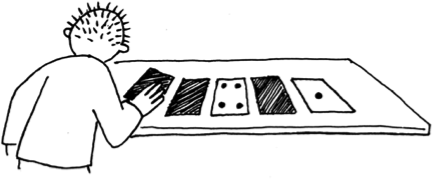Contrasting unplugged and offline computing activities
29 September 2020

Image credit: "Binary Numbers" by CS Unplugged is licensed under CC BY-SA 4.0
As a discipline, computing is rich with abstract concepts to understand and technical skills to master. In order to flourish, students need a wide variety of learning experiences that carefully marry theoretical understanding with hands-on and practical experience. Most of the time, this experience involves the use of computing devices and specialist software that is either a requirement of or enhancement to the learning experience.
There are, however, circumstances where educators may need or choose to:
- Leave their devices behind, and/or
- Step back from the context of computing altogether
The first of these are referred to as ‘offline activities’, and the latter are known as ‘unplugged activities’. Whilst the two are often confused or conflated, in this article, I hope to draw a distinction.
Both offline and unplugged activities can contribute to effective teaching and learning in computing, and numerous examples can be found across KS1 to KS4 in the Teach Computing Curriculum. Despite both approaches being ‘away from the computer’, each is distinct, and enacted through a number of different activities.
Offline activities
‘Offline activities’ could be simply defined as “learning activities that do not use a computer or computing device”.
Often, educators may opt to include an offline activity in their lessons out of necessity. For example, this may be because they lack the equipment they really need to deliver the lesson at its best, or they need to respond to unforeseen situations such as power cuts or network outages (or my personal favourite, having to relocate due to a bird trapped in my computer suite). Over my teaching career, I gradually built up a collection of ‘backup’ lessons that could be used in such eventualities. These activities were rarely optimal, but they helped move the learning forward in tricky situations.

However, in contrast to this ‘backup’ approach, there are many occasions where educators can and should, for pedagogical reasons, incorporate offline activities into their teaching. There are a number of circumstances where choosing to work offline may be beneficial to learning:
- Reading and tracing code before writing is shown to be beneficial, and students may find this more accessible with pen and paper.
- In computing, we often need students to design something (algorithms, interfaces, storyboards, websites, etc), which could be done away from a computer.
- Calculations and processes such as binary/denary/hex conversions or encoding/decoding can be carried out offline.
- Removing the computing device may reduce the cognitive load faced by the learner having to hold knowledge of the problem along with understanding of the tool or software that they are using.
- Some topics lend themselves to discussion and debate, which may be best facilitated without technology.
One factor that all these examples share is that they involve the application of an idea, skill, or concept, allowing learners to take something that they are familiar with and practise it or connect it with other ideas. What these activities tend not to do is introduce new concepts to students. This is one key way in which they are distinct from unplugged activities.
Unplugged activities
In contrast to offline activities, which are simply about removing technology from the learning experience, unplugged activities decouple a new concept from the context of computing. This more constructivist approach seeks to use learners’ existing knowledge and familiar contexts to explore new computing concepts. Once their understanding is secure, learners are supported in connecting back (‘plugging in’) to the computing context. Therefore, an appropriate definition of ‘unplugged computing’ might be “teaching computing concepts away from the context of computing, to explore concepts through analogy, physical objects, role-playing, puzzles, games, magic, etc”.
Unplugged computing often relies on tangible objects and kinaesthetic activities alongside discussion and collaboration to support learners learning from and with each other. Successful activities make use of analogies and stories to make new concepts accessible to learners and connect them to existing understanding. Combined, these factors help make abstract ideas more concrete and easier to grasp.

An aspect of unplugged activities that can often be overlooked is where they fit within a learning experience — specifically, how to plug back in. Whilst an unplugged activity helps to explore a computing concept in a familiar context, the learning needs to connect back to computing, otherwise learners are left only understanding that concept in the context in which they are exploring it. For example, in a lesson focused on understanding what an algorithm is, you might use an unplugged activity based on following recipes and explore the importance of sequence, precision, and repeatability. If you neglect to reconnect with the concept of algorithms, by perhaps exploring how they are similar to and distinct from recipes, you leave students thinking that ‘algorithms’ and ‘recipes’ are synonymous.
This idea of plugging back in and reconnecting links to semantic wave theory. The approach suggests that learning experiences should follow a wave where learning begins in the abstract and is gradually unpacked and made more concrete using everyday contexts and language. Unplugged computing is an example of an activity that sits at the bottom of the wave, making concepts as concrete as possible, before repacking and reconnecting with the original abstract concept.
There are many great examples of unplugged activities available, including from CS Unplugged, csfn, and the Teach Computing Curriculum. You’ll find some of our favourite examples below.
- I liked creating different network topologies using string and students, and then timing how long it took to send data across the network. (Rebecca Franks)
- Also on the theme of networking, I loved showing students how packet switching works as an unplugged activity. It’s commonly used; I’d get them to act as DNS servers, routers, clients, and servers, and pass paper ‘packets’ around. (Ben Garside)
- When introducing binary numbers, I used to get the class into teams. Each team lined up side by side. I used to show a denary number, then they had to kneel to represent 0 and keep standing to represent 1 in order to show the binary number of the denary. (Matt Hogan)
- There’s an activity in ‘Programming essentials in Scratch’ (Year 7) that sees students perform a musical composition to better understand sequencing and timing. (Ben Garside)
Read more
You can read more about semantic wave theory in our sixth Pedagogy Quick Read.
About the author

James Robinson, Senior Learning Manager (Pedagogy), Raspberry Pi Foundation